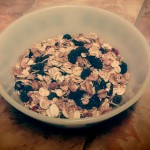 It has been said that oats were widely eaten in Scotland but fed to the horses in England. Whether this resulted in England having good horses and Scotland having fine men as suggested by James Boswell, I have no idea. The point is though that oats have a reputation for providing good health to those who consume them regularly and this has been known for many centuries. Historically, oats are not eaten in such great quantities as some other cereals probably because of their bland taste. However, in recent years their popularity has improved and consumption has increased. This is largely because a growing body of research shows that oats possess many health benefits and incorporating them into our diets may reduce the chance of developing cardiovascular disease.
It has been said that oats were widely eaten in Scotland but fed to the horses in England. Whether this resulted in England having good horses and Scotland having fine men as suggested by James Boswell, I have no idea. The point is though that oats have a reputation for providing good health to those who consume them regularly and this has been known for many centuries. Historically, oats are not eaten in such great quantities as some other cereals probably because of their bland taste. However, in recent years their popularity has improved and consumption has increased. This is largely because a growing body of research shows that oats possess many health benefits and incorporating them into our diets may reduce the chance of developing cardiovascular disease.
The majority the research surrounding the health benefits of oats have focused on the effect on cholesterol levels in the blood. Oats are able to lower total cholesterol and LDL cholesterol and some studies have shown an ability to increase HDL cholesterol levels in the blood, all of which may decrease the risk of developing cardiovascular disease in certain population groups. Oats have also show the ability to improve endothelial function in humans, for example by increasing flow-mediated vasodilation. This would tend to suggest that the benefits of oats on cardiovascular function in multifactorial. The exact mechanism by which oats are able to achieve these changes in not known and research is ongoing, but studies have investigated various phytochemical components of oats and found many of them to have beneficial health giving properties in humans.
Oats are unusual when compared to other cereals because they have a much higher protein and fat content. Although they still provide a large amount of carbohydrates, protein can make up around 13 % of the calories. The high mono and polyunsaturated lipid content (around 20 % of calories) gives oats their tendency to spoil. However, this lipid content is important because this fat in oats contains high levels of vitamin E. Vitamin E is actually a number of different chemicals that all possess similar biological activity. Vitamin E is is made up of eight compounds, which are alpha, beta, gamma and delta-tocopherol and alpha, beta, gamma and delta-tocotrienol. In oats, the tocotrienols tend to be in the bran, while the tocopherols tend to be in the germ. Whole rolled oats therefore contain both tocotrienols and tocopherols.
The total concentration of vitamin E in oats ranges from 20 to 80 mg per kg, and of that over half is alpha-tocotrienol. This combination of tocopherols and tocotrienol gives oats some very beneficial properties as both forms of vitamin E have been shown to have protective effects against cardiovascular disease. Alpha tocopherol is widely researched and much is known about its beneficial effects on cardiovascular disease. For example results from clinical intervention trials published in the Lancet in 19961 showed that 400 iu of alpha tocopherol a day for 510 days significantly reduced the recurrence of heart attacks. This was likely due to the ability of alpha tocopherol to decrease platelet aggregation, which reduces the formation of blood clots that may lead to heart attacks. In addition, alpha tocopherol has been extensively researched in its capacity to inhibit the proliferation of smooth muscle and inhibit oxidation of blood lipids, both of which may prevent the progression of atherosclerosis.
Research has suggested that the antioxidant activity of tocotrienols on lipids in the blood is even greater than that of the tocopherols. This is because tocotrienols are recycled more quickly than tocopherols after quenching lipid oxidation. Tocotrienols are also located closer to the surface of the cell membranes which means they have enhanced interaction with lipid oxides. The ability of oats to reduce cholesterol levels is very likely directly linked to their tocotrienol content. Studies indicate that tocotrienols are able to inhibit HMG-CoA reductase, the enzyme responsible for the synthesis of cholesterol in humans. Even more interestingly, tocotrienols have also been shown to be able to slow or halt the progression of atherosclerosis, which results in a narrowing of the arteries. In fact, some evidence indicates that high dose tocotrienol supplementation are able to regress atherosclerotic lessions.
Tocopherols are widely available in health food stores and are reasonably priced, and so it makes sense to incorporate them in the diet in supplemental form. You could also supplement with tocotrienols, but they are more expensive and not widely available yet. Because supplements are expensive and difficult to find, it makes sense to incorporate oats into the diet because it is one of the only food sources of reasonable levels of tocotrienols. Oats also contain beneficial water soluble dietary fibre as well as a range of other antioxidants which include phytic acid, carotenoids, phenols, saponins and sterols which studies have identified as beneficial to the health. The high sugar, low nutrient content of other breakfast cereals also makes the incorporation of oats into the diet an important consideration. Definitely to be recommended on a cold winter morning, even if you live south of the border.
RdB
